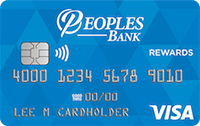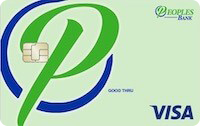Posted On: July 24, 2018 by Peoples Bank in: Business Cyber Security Financial Education General Security

Tips to protect yourself and online bank accounts from attack
Online data breaches have popped up in headlines all over the globe in recent years. The number of attacks has risen dramatically in the last decade and reached a high point in 2017, with 868 reported cybersecurity attacks. The Equifax breach and the “WannaCry” ransomware attack stayed in the news cycle for weeks, affecting many people and companies around the world.
Online banking in particular is an industry that desires a lot of attention. People can access their bank accounts from anywhere: their mobile phones, laptops or desktops. They are as connected as ever, but the ever-growing connectivity also leaves the potential for attacks, especially if customers aren’t careful.
Staying industry-standard has become a priority for banks and remains a crucial part of what we do at Peoples Bank. People’s lives depend on their finances.
“Electronic banking security is essential to protect a customer’s sensitive information, personal data and funds,” said Wanda Knobbe, Peoples Bank Vice President and Internal Auditor. “Their personal lives can be affected in countless ways if their data is compromised.”
While online bank accounts are encrypted and secure on the back end, common mistakes can leave you vulnerable to attacks. We asked Knobbe for tips on how to be proactive in protecting your computer and accounts, recognizing risks and mitigating breaches if they do happen.
Avoid phishing attacks
One of the most common ways attackers try to gain access to customer accounts is through phishing attempts. Phishing is the practice of sending emails claiming to be from a reputable source to convince people to reveal personal information, such as passwords.
Most times, the emails try to entice people to click on a link or open attachment, so it’s best to avoid clicking on anything unless you know and trust the sender.
These emails could pack malware, ransomware or similar items that can affect your computer without your knowledge. Attackers can then monitor your banking transactions or collect your login credentials.
The same can be said for fraudulent phone calls, which have seen a rise over the past few years. Callers will claim to be from the IRS or local police department, demanding payment to avoid arrest. For the most part, government entities will communicate with you via mail or in person, not over the phone.
Don’t give out account information to a stranger. If you don’t know them, consider it suspicious.
Skip banking on public Wi-Fi
While it may be tempting to pay some bills or take a look at your account over the free Wi-Fi at Starbucks, steer clear. It can leave you vulnerable to an attack. Many webpages are encrypted for extra protection, but it’s better to be safe than sorry. Bank on your private home network, rather than in a public space.
If you have to, connect to your cellular data plan rather than Wi-Fi.
Keep passwords up to date and tough
One of the easiest things to do to protect your account is password management. Best practice is to have different passwords for different systems, so a breach won’t affect every single one of your accounts.
Also create a password that’s tough to guess. Think of a phrase, then change it into a shortened form. For example: The phrase “You are always too nice to me!” can be changed to “URa2n2m!” For the toughest passwords, use a combination of uppercase and lowercase letters, numbers and special characters.
Changing passwords regularly can also be helpful. And never share your password with anybody.
Other proactive tips
- Maintain anti-virus, anti-malware, firewalls and update your computer with the latest patches.
- Watch your account activity daily. This way you can catch a breach early in the process.
- If you see anything suspicious, always report it to your financial institution to help protect yourself.
Warning signs of an attack
So how do you know if your systems have been attacked? Sometimes common warning signs go missed early on in the process, when something can be done about it.
Here are some warning signs:
- Unable to log in to bank account
- Reduced computer speed or even a frozen system
- Inability to shut the computer down
- Unexpected rebooting
- Unusual pop-up messages
- Changes in the way items appear on the screen, such as new toolbars or icons
- Unexpected request for a password in the middle of a session
If any of these happen to you, act fast to mitigate the damage.
What to do if you are attacked
If you suspect your computer or online bank account has been breached, the first thing you should do is disable online banking access until the issue is resolved. If there is malware on your computer, the last thing you want is to give it access to your sensitive information.
Beyond banking, don’t connect to other confidential sites either, such as credit card accounts, medical information or loan accounts for the same reasons.
After blocking access, take your computer to be cleaned and secured by a trusted source and reset the passwords on all of your accounts. Work with your bank to get new accounts and numbers.
If your secure online banking accounts have been comprised, it’s best to act fast. In some cases, you can be reimbursed for damages if you report to authorities in a certain timeframe. Don’t procrastinate. Your bank and authorities can work to close your account and protect you from any more losses.
In the future, look at your credit report to see if the attackers opened any new accounts in your name or if there are any debts you are unaware of.
As the nature and frequency of attacks change, we hope this blog serves a quick guideline for how to avoid and mitigate the damage of an attack.
“As the nature of online banking has evolved and allowed higher-risk transactions such as the movement of funds by the customer, so has the need for stronger, multifactor and layered authentication methods,” Knobbe said. “As technology continues to advance, it’s essential for the bank to best serve the customer while also assuring the best security practices for that customer.”




